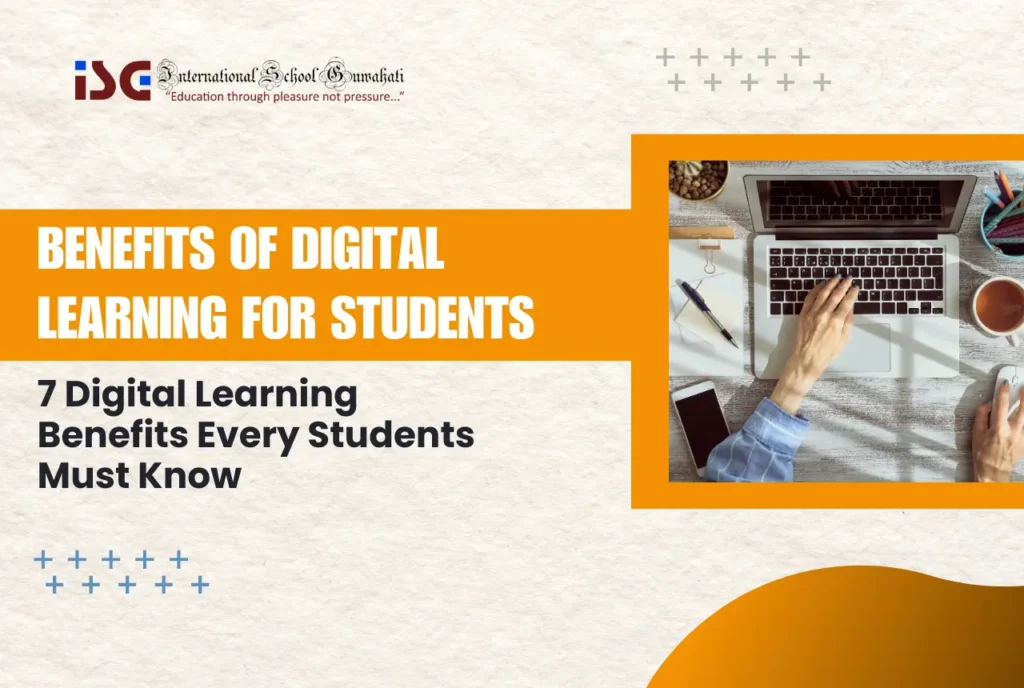![]()
The world has moved online. Every part and aspect of our lives has an online angle to it. This is giving us options before it gets necessary to do things online only. The same is true when it comes to education.
It seems like we used to extract our study materials from the library a long time ago. Now we have gotten so well-versed in its digital aspect that education seems impossible with it now.
Therefore, in this blog, we are going to walk you through 7 amazing benefits of digital learning.
Here are Some of the Major Benefits of Digital Learning for Students
1. Personalized Learning Experiences

Imagine a learning environment that adapts to your unique needs. Digital learning platforms can do just that. They utilize adaptive learning technologies that assess your strengths and weaknesses, tailoring the learning content and pace to your learning style. No more feeling lost or bored – you can learn at a comfortable speed that allows for deeper comprehension.
Additionally, personalized learning plans let you focus on specific areas of interest, making your learning journey more relevant and rewarding. Platforms like Khan Academy and IXL Learning offer these personalized features.
Personalized e-learning advantages also encourage self-development and quality learning as the student is allowed liberty to learn in his or her own time and comfort.
2. Broader Access to Learning Resources

Gone are the days of bulky textbooks and limited resources. Digital learning platforms provide a vast library of information at your fingertips. These platforms often feature engaging multimedia content like interactive simulations, educational videos, and infographics that make learning fun and visually stimulating. It engages younger students as well and fosters a deeper understanding of the concept.
Unlike traditional textbooks, these materials are constantly updated, ensuring you have access to the updated information. Accessibility is another key advantage. Many platforms offer downloadable content and screen reader compatibility, making learning inclusive for students with diverse needs. One can access it from multiple devices with a working internet connection.
3. Increased Engagement and Motivation

Let’s face it, traditional lectures can sometimes feel monotonous. Digital learning offers a more dynamic and interactive experience. Platforms incorporate gamification elements, like points, badges, and leaderboards, that turn learning into a game, boosting your motivation and making the process enjoyable.
Educational simulations also help students experience concepts in a virtual environment, fostering a deeper understanding of complex topics. And with asynchronous learning, you have the flexibility to learn when you learn best, whether it’s early in the morning or late at night.
4. Development of Digital Literacy Skills

In today’s digital world, digital literacy skills are essential for success. Digital learning environments require you to use technology for research, communication, and critical thinking. With every business moving online, they need their customers and staff to be able to access some level of technology.
You’ll learn how to navigate online resources, evaluate information, and use technology effectively to solve problems. These skills are not only valuable for academic success but also crucial for future careers in a world increasingly reliant on technology.
5. Enhanced Collaboration and Communication Skills
Digital learning isn’t just about individual study. Many online platforms offer excellent tools for collaboration. Discussion forums, group projects with real-time chat features, and online presentations promote teamwork and communication.
You’ll learn how to effectively communicate your ideas, participate in discussions, and give and receive constructive feedback from peers. This whole process is better supported by the digital resources. Some platforms even connect students from around the world, allowing you to collaborate and learn from diverse perspectives.
There are applications available for mobile phones and computers where students can discuss ideas, share opinions, and take learning to a new level.
6. Real-Time Feedback and Progress Tracking
Digital learning provides you with immediate feedback on quizzes, assignments, and other activities. This allows you to identify areas of improvement and adjust your learning approach quickly.
Learning management systems (LMS) track your progress throughout the course, keeping you motivated and ensuring you stay on track. Platforms like Coursera and edX utilize these features effectively.
7. Fostering a Growth Mindset and Self-Directed Learning

Digital learning encourages you to take ownership of your learning journey. By setting personal goals, exploring different resources, and actively participating in online discussions, you cultivate a growth mindset. Digital learning inculcates a habit of research and the willingness to dig deeper with concepts which only enhances the learning process.
You learn to see challenges as opportunities to learn and grow, fostering resilience and independence. This self-directed learning approach empowers you to become a resourceful and lifelong learner.
Traditional vs. Digital Learning: Embracing the Future of Education
Traditional classroom learning provides a structured environment with valuable face-to-face interaction. However, it can be limited by fixed learning paces and access to resources.
Digital learning offers a flexible and personalized approach, but it requires strong time management and self-discipline. Then what is an ideal scenario? A blended learning approach that incorporates the best of both worlds.
Getting Started with Digital Learning: Resources for Students
There’s a wealth of digital learning resources available for students of all ages and interests. Popular platforms include:
- K-12: Khan Academy, IXL Learning, National Geographic Kids
- Higher Education: Coursera, edX, Udemy
- Adult Learners: LinkedIn Learning, Skillshare, MasterClass
These platforms offer various course formats, including MOOCs (Massive Open Online Courses), SPOCs (Small Private Online Courses), and micro-credentials.
Choosing a Reputable Platform
Consider your learning goals, budget, and preferred learning style when selecting a platform. Look for platforms with accredited courses, positive user reviews, and strong support features.
Remember, success in online learning environments requires strong time management and self-discipline. Develop a study schedule, set realistic goals, and create a dedicated learning space to minimize distractions. Don’t hesitate to utilize the platform’s support features and reach out to instructors or classmates for help.
Conclusion
The benefits of digital learning for students are far-reaching and foster a more personalized, engaging, and effective learning journey.
From personalized learning plans and vast resources to real-time feedback and collaboration opportunities, digital learning empowers you to take control of your education and become a successful lifelong learner.
So, embrace the digital revolution in education and unlock the potential for a richer, more rewarding learning experience!







